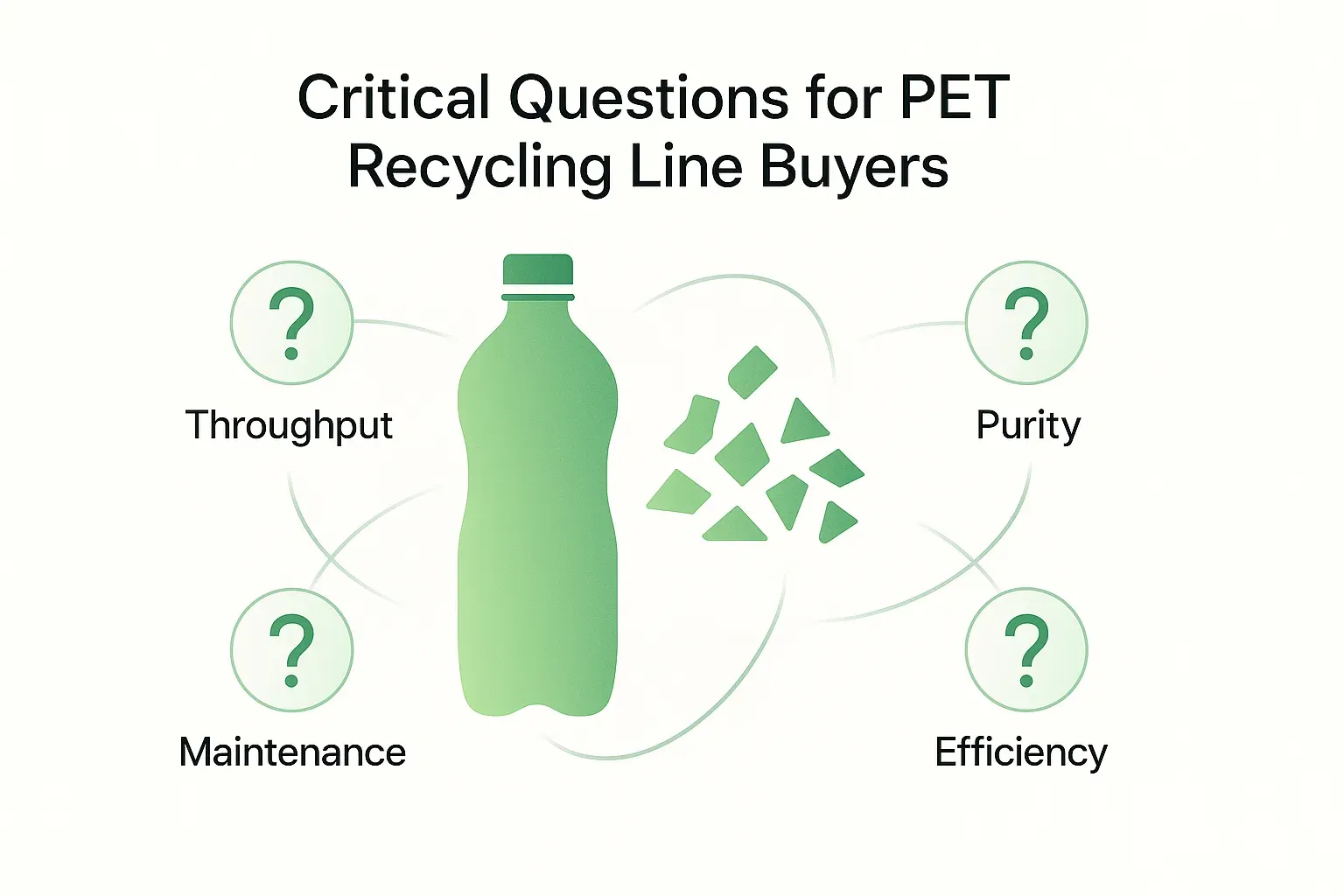Key Technical Questions for Your PET Bottle Recycling Line Purchase
Investir em um PET bottle recycling line is a significant decision. To ensure you select equipment that meets your specific operational needs and delivers high-quality rPET flakes, asking the right technical questions is paramount. This guide will walk you through crucial considerations, helping you engage confidently with suppliers.
1. Understanding Capacity and Throughput
The very foundation of your selection process lies in matching the line’s capacity to your processing requirements.
- What is the nominal and actual processing capacity (e.g., kg/hour or tonnes/hour) of the line? Understand if this refers to input material or output flakes.
- How does the line’s design accommodate fluctuations in input volume?
- What are the bottlenecks in the system, and how can they be managed?
Clarity on capacity ensures the line can handle your current and anticipated future volumes, preventing underutilisation or overwhelming the system.
2. Input Material Specifications
The quality and nature of your input PET bottles significantly impact the line’s design and performance.
- What types of PET bales can the line process (e.g., highly contaminated, mixed colours, post-consumer)?
- What is the acceptable level of contamination (e.g., PVC, other plastics, metals, paper, organic matter)?
- Does the line include pre-sorting or bale breaking capabilities effective for my specific input?
A line designed for cleaner, pre-sorted bales might struggle with highly contaminated feedstock, affecting efficiency and output quality.
3. Desired Output rPET Flake Quality
The end-use of your rPET flakes dictates the required quality. This is a critical discussion point.
- What are the target specifications for the final rPET flakes? Consider:
- PVC content (ppm)
- Moisture content (%)
- Bulk density (g/cm³)
- Flake size distribution (mm)
- Presence of other polymer contaminants (e.g., PE, PP)
- Colour contamination (for clear flakes)
- Intrinsic Viscosity (IV) levels (if relevant for your application)
- What quality control measures are integrated into the line to ensure consistent output?
Suppliers should be able to demonstrate how their Máquina de reciclagem de garrafas PET components achieve these specific parameters.
Typical PET Bottle Recycling Line Process Flow
Understanding the typical stages involved can help you pinpoint areas for specific questioning. While configurations vary, a common flow includes:
Each stage involves specific machinery; inquire about the technology used in each.
4. Washing and Separation Technologies
The cleaning stages are critical for removing contaminants and achieving high-purity rPET.
- What type of washing system is employed (e.g., hot wash, cold wash, friction washers)?
- What chemicals are recommended, and what are their consumption rates? How is dosing controlled?
- How effective is the label and cap separation system (e.g., sink-float tanks, air classifiers)?
- Are there specific features for removing glues and stubborn residues?
5. Drying Efficiency
Achieving low moisture content in the final flakes is vital for subsequent processing and storage.
- What drying technologies are used (e.g., mechanical dewatering, thermal drying)?
- What is the guaranteed final moisture content of the rPET flakes?
- How is the drying temperature controlled to prevent flake degradation (e.g., yellowing, IV drop)?
6. Water and Energy Consumption
Operational costs are heavily influenced by resource consumption. Aim for efficiency.
- What is the specific water consumption (e.g., m³/tonne of rPET)?
- Does the line include a water treatment and recycling system? What are its capabilities and maintenance requirements?
- What is the total installed power and estimated energy consumption (kWh/tonne of rPET)?
- Are there energy-saving features, such as high-efficiency motors or heat recovery systems?
7. Automation, Control, and Maintenance
A user-friendly and maintainable line enhances productivity and reduces downtime.
- What level of automation is provided (e.g., PLC control, HMI interface)?
- Are remote monitoring and diagnostic capabilities available?
- How easy is it to access components for routine maintenance and cleaning?
- What is the expected lifespan of critical wear parts (e.g., crusher blades, screens)? What are their replacement costs and availability?
- What are the recommended maintenance schedules?
8. Footprint, Installation, and Safety
Practical considerations for integrating the line into your facility are essential.
- What is the overall footprint and layout of the proposed PET bottle recycling line? Will it fit your available space?
- What are the supplier’s responsibilities regarding installation, commissioning, and operator training?
- What safety features are incorporated (e.g., emergency stops, safety guards, interlocks)? Does it comply with relevant safety standards?
9. Supplier Support and Warranty
A reliable supplier offers more than just machinery; they provide ongoing support.
- What warranty terms are offered for the complete line and individual components?
- What is the availability of technical support and spare parts? What are the lead times?
- Can the supplier provide references from existing customers with similar installations?
- What post-installation services are offered (e.g., performance optimisation, upgrades)?
Conclusão: Tomando uma decisão informada
Purchasing a PET bottle recycling line requires thorough due diligence. By asking these detailed technical questions, you can better evaluate supplier proposals, compare different technologies, and ultimately select a system that aligns with your business goals, budget, and quality requirements. Remember, a well-chosen line is an investment in efficiency, sustainability, and profitability.
Take your time, gather all necessary information, and partner with a supplier who demonstrates expertise and a commitment to your success.



